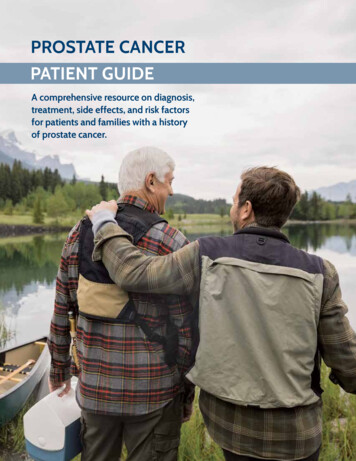
Transcription
PROSTATE CANCERPATIENT GUIDEA comprehensive resource on diagnosis,treatment, side effects, and risk factorsfor patients and families with a historyof prostate cancer.
“ Be vigilant, live healthy,and don’t give up. This diseasecan be conquered.”— FORMER COMBAT MARINE, KOREAN WAR
About this guideThere are no two ways about it: getting diagnosed with cancer is hard and itis life-changing. Despite increasing optimism about treatment, today’s cancerlandscape can be challenging as patients have access to an unprecedentedamount of information. There are literally millions of cancer-related webpages,blogs, and videos available at your fingertips. But it’s important to acknowledgethat this isn’t always a helpful thing. A cancer diagnosis can be disorienting,and for many, the overwhelming volume of information available can be moreof a burden than an aid.This guide focuses all of the information available about contemporary prostatecancer research, treatment, and lifestyle factors into one consolidated resource. Itis for any man who has been newly diagnosed, who is in treatment, or is concernedabout a rising PSA. Beyond that, it’s for any loved one or caregiver who wants tocut through the information noise and get directly to need-to-know informationfor prostate cancer patient navigation. Lastly, as we are beginning to recognize thegenetic underpinnings of cancer, this guide is for any family member who mightwant to understand how their shared genes affect their own short- and long-termrisks factors—and whether they should be screened as well.We gratefully acknowledge the contributions of Daniel Spratt, MD (University of Michigan), Andrew Armstrong,MD (Duke University), Andrea Miyahira, PhD (Prostate Cancer Foundation), Heather Cheng, MD, PhD (Universityof Washington; Fred Hutchinson Cancer Research Center), Bill Curry, Izak Faiena, MD (University of California,Los Angeles), Stacy Loeb, MD, MSc (New York University), Alicia Morgans, MD (Northwestern University),Christopher Sweeney, MBBS (Dana-Farber Cancer Institute; Harvard Medical School), Howard Soule, PhD(Prostate Cancer Foundation) and Skip Holden, MD (Prostate Cancer Foundation), Jonathan Simons, MD(Prostate Cancer Foundation), Julie DiBiase, PhD (Prostate Cancer Foundation).This guide was produced in 2017 by the Prostate Cancer Foundation (PCF). The Prostate Cancer Foundation is theworld’s leading philanthropic organization funding and accelerating prostate cancer research. Since being founded in1993, the Prostate Cancer Foundation has funded key research leading to many of the treatments used by doctorstoday to improve the lives of patients, with the mission that someday, soon, no man will die of this disease.Subjects depicted are models and are used for illustrative purposes only. Prostate cancer standards of practicechange regularly. For the most up-to-date information, please register for updates at www.pcf.org.PROSTATE CANCER PATIENT GUIDE 31
3 TABLE OF CONTENTSABOUT THIS GUIDE11. ABOUT YOU AND PROSTATE CANCER7GENERAL INFORMATION7WHAT IS PROSTATE CANCER?7SURVIVING PROSTATE CANCER7RATES OF DIAGNOSIS7RISK FACTORS9SYMPTOMS9HISTORY & PROGRESSMEDICAL BASICS1011THE ANATOMY OF THE PROSTATE12THE BIOLOGY OF PROSTATE CANCER12UNDERSTANDING METASTASIS13WHAT IS PSA?13THE BIOLOGY OF SEX STEROIDS14PRECISION ONCOLOGY152. FOR THE NEWLY DIAGNOSED17UNDERSTANDING YOUR DIAGNOSIS17DETECTION, DIAGNOSIS AND STAGING17MAKING THE DIAGNOSIS VIA BIOPSY17STAGING YOUR DISEASE18SELECTING YOUR TREATMENT19ASSEMBLING YOUR TEAMDOCTORS AND PRACTITIONERS2020FAMILY21YOUR SUPPORT NETWORK21YOU22PROCESSING YOUR DIAGNOSIS22TEAR SHEET: QUESTIONS TO ASK YOUR DOCTOR AFTER INITIAL DIAGNOSIS232 3 TABLE OF CONTENTS
3. TREATMENT OPTIONS FOR LOCALIZED OR LOCALLY ADVANCED PROSTATE CANCER25CHOOSING A TREATMENT OPTION25RISK GROUPS25ACTIVE SURVEILLANCE27WHO SHOULD CHOOSE ACTIVE SURVEILLANCE?28SURGERY28RADIATION30EXTERNAL BEAM RADIATION THERAPY (EBRT)30BRACHYTHERAPY31HORMONE THERAPY WITH RADIATION32OTHER THERAPIES FOR LOCALIZED PROSTATE CANCER32CRYOTHERAPY33HIGH INTENSITY FOCUSED ULTRASOUND (HIFU)33PRIMARY HORMONE THERAPY334. LIVING WITH AND AFTER PROSTATE CANCER35IN TREATMENT: WHAT TO EXPECT35MONITORING FOR RECURRENCE35MENTAL HEALTH35MAXIMIZING QUALITY OF LIFE35POSSIBLE SIDE EFFECTS36URINARY FUNCTION36BOWEL FUNCTION36FERTILITY37SEXUAL FUNCTION37PERMANENT UPGRADES TO HEALTHY LIVING40DIET40EXERCISE40LIFESTYLE CHANGES40PROSTATE CANCER PATIENT GUIDE 33
5. WHAT TO DO IF YOUR PSA STARTS TO RISE43DETECTING RECURRENCE43UNDERSTANDING THE NUMBERS43PSA VELOCITY44LOCAL TREATMENTS FOR RECURRENT PROSTATE CANCER45SALVAGE RADIATION THERAPY FOLLOWING SURGERY45SALVAGE PROSTATECTOMY FOLLOWING RADIATION46BRACHYTHERAPY FOLLOWING EXTERNAL BEAM RADIATION46CRYOTHERAPY FOLLOWING RADIATION46HORMONE THERAPY FOLLOWING RADIATION46THERAPIES FOR ADVANCED (METASTATIC) PROSTATE CANCER47PRIMARY HORMONE THERAPY47TYPES OF PRIMARY HORMONE THERAPY (ANDROGEN DEPRIVATION THERAPY OR ADT)47INTERMITTENT HORMONAL THERAPY48COMBINATION TREATMENTS FOR “HORMONE-NAIVE” PROSTATE CANCER49THERAPIES FOR HORMONE RESISTANT PROSTATE CANCER50SECOND-LINE HORMONE THERAPIES50NON-HORMONAL THERAPY OPTIONS51TAXANE CHEMOTHERAPY51PLATINUM CHEMOTHERAPY52SIPULEUCEL-T N53OTHER BONE TARGETING TREATMENTS54SIDE EFFECTS FROM TREATMENTS FOR ADVANCED PROSTATE CANCER55SIDE EFFECTS OF HORMONE THERAPY55SIDE EFFECTS OF CHEMOTHERAPY564 3 TABLE OF CONTENTS
6. CUTTING EDGE DEVELOPMENTS IN PROSTATE CANCER RESEARCH59WHAT IS PRECISION MEDICINE?59EMERGING NEAR-TERM THERAPIES59PARP INHIBITORS59PROSTVAC60THE FUTURE LANDSCAPE OF PROSTATE CANCER PRECISION THERAPY60IMMUNE CHECKPOINT INHIBITORS60PSMA RADIONUCLIDE THERAPY60CAR T CELLS60CLINICAL TRIALS: HOW TO GET INVOLVED617. FOR OUR SONS & DAUGHTERS63THE GENETICS OF RISK63SCREENING FOR PROSTATE CANCER63SHOULD MY FAMILY BE SCREENED?63WHEN TO START—AND STOP—SCREENING64SCREENING AND BIOPSY65PROSTATE CANCER GENES IN FAMILIES65“CASCADE” GENETIC TESTING66THE NUANCES OF GENETIC SCREENING67PREVENTION67DIET AND EXERCISE68PROSTATE CANCER PATIENT GUIDE 35
33“ Keep on living your life. I’ve never letanything interfere with my treatments,but I’ve continued to live the life I wantto lead.”— PATIENT6 3 ABOUT YOU AND PROSTATE CANCER
1 3 ABOUT YOU AND PROSTATE CANCERGENERAL INFORMATIONWhat is Prostate Cancer?In general, cancer is a condition in which a normal cellbecomes abnormal and starts to grow uncontrollablywithout having the signals or “brakes” that stop typicalcell growth. Prostate cancer starts in the prostategland, a small gland located below the bladder, thatis responsible for secreting one of the components ofsemen. Prostate cancer cells form masses of abnormalcells known as tumors.Prostate cancer, therefore, is when a normalprostate cell becomes altered and startsgrowing in an uncontrolled way.In many cases, prostate cancer is relatively slowgrowing, which means that it takes a number of yearsto become large enough to be detectable, and evenlonger to spread outside the prostate, or metastasize.However, some cases are more aggressive and needmore urgent treatment.Surviving Prostate CancerApproximately 95% of all prostate cancers are detectedwhen the cancer is confined to the prostate, so treatmentsuccess rates are high compared to most other types ofcancer in the body. The 5-year survival rate in the UnitedStates for men diagnosed with prostate cancer is 99%.In other words, the chances of the cancer spreading ormen dying from their prostate cancer is generally low.However, prostate cancer comes in many forms andsome men can have aggressive prostate cancer evenwhen it appears to be confined to the prostate.Amidst so much optimism and progress in thelast 10 years, it’s important to keep in mind thatprostate cancer is still a deadly disease for somemen, and it is the second leading cause of cancerdeath among men in the US, with nearly 88 mendying from it every day.In general, the earlier the cancer is caught andtreated, the more likely the patient will remaindisease-free. In fact, many men with “low-risk”tumors, which are the most common type ofprostate cancer, can safely undergo ActiveSurveillance, in which they are monitored withoutimmediate treatment (and treatment-related sideeffects) while still preserving their chance of longterm survival if the cancer becomes aggressiveenough to require treatment.Rates of DiagnosisProstate cancer is the leading cause of non-skincancer in the US, and the second leading cause ofcancer worldwide; approximately 1 in 8 men will bediagnosed with prostate cancer at some point in theirlives. The older you are, the more likely you are to bediagnosed with prostate cancer.Although only about 1 in 350 men under age 50 willbe diagnosed, the rate shoots up to 1 in 52 for ages50 to 59, 1 in 19 for ages 60 to 69, and 1 in 11 for men70 and older. Nearly 60% of all prostate cancers arediagnosed in men over the age of 65.IS THERE A CURE FOR PROSTATE CANCER?When people think about cancer treatment success, they often think of the word “cure.” Sometimesstatisticians think of “cure” as a function of time: is 5 years without a cancer recurrence equal to a cure? Or isit 10 years? Unfortunately, in some men, prostate cancers can recur even 10 years after treatment. So insteadof using the term “cure,” doctors commonly use terms such as biochemical control (PSA levels kept at bay withmedication) or freedom from developing metastatic disease (the cancer has not spread to distant organs) tohelp quantify the success of prostate cancer treatment.PROSTATE CANCER PATIENT GUIDE 37
317 genesthat run in families have beendiscovered that have overlap fromprostate cancer to other cancers.Prostate cancer is 100%treatable if detected early.3100%3Since 1993, deaths from prostatecancer have been cut in half.Prostatecancer hasone ofthe highestsurvivalrates ofany cancer.If the prostate cancer is caughtat an early stage, most men willnot experience any symptoms.10 THINGS TO KNOWThanks to emerging science, in thenext 5 years, we may see an endto all incurable prostate cancer.A man of African descent is70% more likely to developprostate cancer.70%As men age, their riskof developing prostatecancer increasesexponentially.2x8 3 ABOUT YOU AND PROSTATE CANCERProstate cancer is themost commonnon-skin cancer in America.Men with relatives with a history of prostatecancer are twice as likely to develop the disease.
Prostate cancer is diagnosed with a biopsy. The mostcommon reason for a man to undergo a prostate biopsyis due to an elevated prostate-specific antigen level,or PSA, determined by a blood test. Recent changes inPSA screening recommendations have impacted therates of prostate cancer diagnosis (see Screening forProstate Cancer, page 63).Risk FactorsAs indicated by the rates of diagnosis, age is thebiggest—but not the only—risk factor for prostatecancer. Other important factors include family history,genetic factors, race, and lifestyle and dietary habits.Genes for disease can run in families. Men who havea relative with prostate cancer are twice as likely todevelop the disease, while those with 2 or more relativesare nearly 4 times as likely to be diagnosed. The riskis even higher if the affected family members werediagnosed before age 65. Men may also be at increasedrisk of prostate cancer if they have a strong familyhistory of other cancers, such as breast cancer,ovarian cancer, colon cancer, or pancreatic cancer.Because family members share many genes, there maybe multiple genetic factors that contribute to the overallrisk of prostate cancer in a family. However, there arealso some individual genes that we now know increasethe risk of prostate cancer, and men with these genesmay need to be screened differently or considerchanges in treatment.It is still a scientific mystery, but African Americanmen are 73% more likely to develop prostatecancer compared with white men, and 2.4 timesmore likely to die from the disease.Although there is clearly a disproportionate number ofAfrican American men who are diagnosed with prostatecancer, the increased death rate from prostate cancerhas been shown to be due in part to inequality ingetting access to healthcare, insurance, PSA screening,appropriate treatment and follow-up, other simultaneousconditions or treatments, and other socioeconomicfactors. There is ongoing research to try to identifywhether there are biological differences between cancersthat develop in African American men so that we canimprove treatment. It is also important to realize thatnot every African American man will get prostate cancerand that prostate cancer has a better chance of beingmanaged effectively and cured if it is detected early.Other risk factors for prostate cancer are social andenvironmental factors—particularly a high fat, highprocessed carbohydrate diet—and lifestyle. Menwho are overweight or obese are at greater risk ofultimately developing an aggressive form of prostatecancer. Research has shown that in obese men,recovery from surgery tends to be longer and moredifficult, and the risk of dying from prostate cancercan be higher.SymptomsIf you’ve recently been diagnosed with prostatecancer, you may be asking yourself if there werewarning signs or symptoms you should havenoticed earlier. Unfortunately, there usually aren’tany early warning signs for prostate cancer. Thegrowing tumor does not push against anything tocause pain, so for many years the disease may besilent. That’s why screening for prostate cancer issuch an important topic for all men and their families.In rare cases, prostate cancer can cause symptomsthat include:3A need to urinate frequently, especially at night,sometimes urgently3D ifficulty starting or holding back urination3W eak, dribbling, or interrupted flow of urine3P ainful or burning urination3D ifficulty in having an erection3A decrease in the amount of fluid ejaculated3P ainful ejaculation3B lood in the urine or semen3P ressure or pain in the rectum3P ain or stiffness in the lower back, hips,pelvis, or thighsPROSTATE CANCER PATIENT GUIDE 39
However, urinary symptoms don’t necessarilymean you have cancer. Prostatitis or BPH (BenignProstatic Hypertrophy, also known as enlargementof the prostate) are benign diseases but can causesimilar symptoms and are very common.What about difficulty in having an erection? Again,this is most likely not caused by cancer but by otherfactors such as diabetes, smoking, cardiovasculardisease, or just plain getting older.Remember: Symptoms are symptoms, andno matter what’s most likely to be causingthem, you should get them checked out bya doctor.History & ProgressModern prostate cancer research was framedin the 1940s by the discovery that hormones,primarily testosterone, were responsible for thegrowth of tumors. Over the next 5 decades, varioustypes of chemotherapy, radiation therapy, surgicaloptions, and hormone therapy were refined.Dr. Jonathan Simons, CEO of the ProstateCancer Foundation, was also one of itsearliest grant recipients in 1994 as a youngphysician-scientist.NUMBER OF DEATHS PER 100,000 MEN (ALL RACES), AGE-ADJUSTEDBreakthroughs in Prostate Cancer Treatment and Practice1993PCF founded by philanthropist Michael Milken1994FDA approves PSA screeningfor prostate cancer45402003Human genome sequenced2000Robotic surgeryapproved by FDA353025201998First LHRHagonistapproved15102002First LHRHantagonistapproved50199019911992199310 3 ABOUT YOU AND PROSTATE CANCER1994199519961997199819992000200120022003
In 1994, the FDA-approved the PSA (prostate-specificantigen) blood test to detect early prostate cancer in menwithout symptoms. Since cancer detected early is mucheasier to treat, use of the PSA test for cancer screening hascontributed to the subsequent increase in the number ofpatients diagnosed early enough to be cured with surgeryor radiation, and resulted in a 52% reduction of deathsfrom prostate cancer over the past 2 decades in the U.S.However, the PSA test sparked concerns that it has led toover-treatment of non-aggressive, slow-growing prostatecancers that would not have caused harm to the patient.Since 1993 when the Prostate Cancer Foundation beganfunding life-prolonging advancements in research,amazing strides have been made in finding therapiesfor treating advanced prostate cancer that are nowpart of an improved standard of care. There havebeen tremendous advancements, including:3 Imaging technology to help find prostate cancer3 Precision radiation therapy3 Development of robotic surgery3N umerous new FDA-approved therapies thathelp men live longerBecause of these improvements and potentiallyother unknown factors, since 1993, deaths fromprostate cancer have been cut in half (from 39.3per 100,000 men in 1993, to 19.1 per 100,000men in 2014).Today, precision medicine, which involves looking atthe DNA of your tumor and its unique genetic profileto match the right drug to the right patient at the righttime, is ushering in a new era in treatment for prostatecancer that may someday lead to DNA testing as a goldstandard in cancer care. Scientists are also exploringhow immunotherapy—the process of using the body’sown immune system to combat disease—can be usedmore effectively in treating prostate cancer.MEDICAL BASICSThe more you know about the normal developmentand function of the prostate, where it’s located, andwhat it’s attached to, the better you can understandhow prostate cancer develops and impacts a man’s lifeover time—due either to cancer growth or as a resultof treatment.*Data available through 20142007IGRT is standard of carefor radiation therapy2008First prostatecancer tumorsequenced2004Docetaxel2015Inherited DNA repair mutationsdiscoveredto drive prostate cancer2016Updated screeningguidelines increasethe use of ActiveSurveillance2010First immunotherapyfor prostate cancer2010Cabazitaxelsipuleucel-T2012Abiraterone& enzalutimide*2017Liquid biopsyfor prostatecancer2017Pembrolizumab2013Radium 5201620172018PROSTATE CANCER PATIENT GUIDE 311
The Anatomy of the ProstateThe prostate is a small, squishy gland about the sizeof a ping-pong ball. It sits under the bladder and infront of the rectum. The prostate is only present inmen and is important for reproduction, because itsupplies the fluids needed for sperm to travel andsurvive (sperm is not made in the prostate; it is madein the testes).The prostate is divided into several anatomic regions,or zones. Most prostate cancer starts in the peripheralzone (the back of the prostate) near the rectum. That’swhy examining the prostate via a gloved finger in therectum, known as digital rectal exam (DRE), is a usefulscreening test.The seminal vesicles are rabbit-eared structures thatstore and secrete a large portion of the ejaculate.These structures sit on top of the prostate.The neurovascular bundle is a collection of nerves andvessels that run along each side of the prostate, helpingto control erectile function. They are usually a shortdistance away from the prostate, but sometimes theyattach to the prostate itself.The bladder is like a balloon that gets larger as it fillsup, holding urine until the body is ready to void. Theurethra, a narrow tube that connects to the bladder,runs through the middle of the prostate and alongthe length of the penis, carrying both urine and semenout of the body. It is the hose that drains the bladder.The rectum is the lower end of your intestines thatconnects to the anus, and it sits right behind the prostate.The Biology of Prostate CancerTo properly understand diagnosis and treatmentoptions, it’s important to understand how prostatecancer grows. A normal prostate uses androgens(including testosterone and dihydrotestosterone, orDHT) during its development and everyday function.Once prostate cancer forms it feeds on androgensand uses them as fuel for growth. This is why one ofthe backbones of treatment for men, especially withadvanced prostate cancer, is to lower a man’s androgenlevels with drugs collectively termed “hormone therapy.”Prostate cancer occurs when a normal prostate cell beginsto grow out of control. In many cases, prostate cancer isa slow-growing cancer that does not progress outside ofthe prostate gland before the time of diagnosis.The Anatomy of the ProstateBladderSeminal vesiclesNeurovascular bundleRectumProstatePeripheral zoneof prostateUrethraTestes12 3 ABOUT YOU AND PROSTATE CANCER
?ANDROGENSQUESTIONAndrogens are hormones that are importantfor many male characteristics and aspectsof reproduction.If my doctor tells me that I have prostate cancermetastases in my bones or my lungs, doesthat mean I have bone cancer or lung cancer?GRADEANSWERGrade is a measure of how abnormal theprostate cancer cells look under the microscope.It’s used to predict how quickly they mightgrow or spread.No. This does not mean you have “bone cancer”or “lung cancer,” since these tumor cells camefrom the prostate and did not develop from boneor lung cells. Your treatment would be focused onprostate cancer rather than bone or lung cancer.The rate of growth and spread of prostate cancer isreflected in the grade of the cancer, measured byeither the Gleason score or the ISUP grade groupclassification.Prostate cancers that are composed of very abnormalcells are much more likely to both divide and spreadfaster from the prostate to other regions of the body.Often, prostate cancer spreads first to tissues that arenear the prostate, including the seminal vesicles andnearby lymph nodes.Researchers have identified various biological andgenetic subtypes of prostate cancer. Although thesesubtypes are typically not yet used to guide treatmentrecommendations, they are the subject of activeresearch funded by the Prostate Cancer Foundation.Understanding MetastasisSometimes cancer cells will escape the prostate andgrow quickly, spreading to nearby tissue. Nearby lymphnodes are often the first destination for a spreadingcancer. If prostate cancer has spread to your lymphnodes when it is diagnosed, it means that there ishigher chance that it has spread to other areas of thebody as well.Metastasis refers to tumor cells leaving theprostate and forming tumors somewhere elsein the body.If and when prostate cancer cells gain access to thebloodstream, they can be deposited in various sitesthroughout the body, most commonly in bones, andmore rarely to other organs such as the liver, lung, orbrain. Bone metastases are seen in 85% to 90% ofmetastatic cases.What is PSA?PSA, or Prostate Specific Antigen, is a protein producedby the prostate and found mostly in the semen, withvery small amounts released into the bloodstream.When there’s a problem with the prostate—such as thedevelopment and growth of prostate cancer—more PSAis released. PSA eventually reaches a level where it canbe easily detected in the blood. This is often the firstindicator of prostate cancer.During a PSA test, a small amount of blood is drawnfrom the arm, and the level of PSA is measured.Doctors look at the overall level of PSA, as well as itsrate of rising (velocity) compared with prior test results.As the PSA number goes up, the chance that cancer ispresent increases. Men whose levels go above 3 or 4 areoften recommended to undergo a biopsy; however,this PSA level does not mean that prostate cancer isdefinitely there, and some cancers may be presenteven when PSA levels are lower.PROSTATE CANCER PATIENT GUIDE 313
THE PSA DEBATEThe PSA is not a perfect test. Elevated levelscan be caused by other benign prostate diseasesand problems, such as BPH (benign prostatichyperplasia, an enlarged prostate) or prostatitis(an infection in your prostate). There is an activedebate around prostate cancer screening. Somehealth care professionals are concerned thatincreased PSA screening is finding many tumorsso slow-growing as to be no threat to the patient,leading to “overtreatment,” and that many menwith these low-risk cancers are getting treatmentsthey do not need but that can have significantside effects. However, there is also data to supportthat PSA testing has reduced the death rate fromprostate cancer, because men with aggressivecancers are diagnosed earlier, often before thecancer has spread, and can be cured and/ormore effectively managed by earlier treatment.PSA screening decisions should be made on a caseby-case basis between the doctor and patient, basedon a full examination of risk factors.Once a man has a confirmed diagnosis of prostatecancer, rising PSA is a useful test to track prostatecancer growth, since it can be detected well beforeany clinical signs or symptoms. The PSA is also widelyaccepted as an invaluable tool for monitoring prostatecancer disease activity and remission from prostatecancer after treatment.The Biology of Sex SteroidsProstate cancer cells are just like all other livingorganisms—they need fuel to grow and survive.The main fuel for prostate cancer growth is thesex hormone testosterone.14 3 ABOUT YOU AND PROSTATE CANCERThe term sex steroid, or sex hormone, refers tothe substances secreted by the testes and ovaries,respectively androgens and estrogens, which areresponsible for the function of the reproductiveorgans and the development of secondary sexcharacteristics (such as facial hair, muscle mass, andsex drive). Androgens and estrogens are present inboth men and women, though at different levels.The most important androgen for male reproductionis testosterone. Testosterone is primarily made in thetestes, but a smaller amount is made in the adrenalglands above the kidneys. The prostate typically growsduring adolescence under the control of testosterone.The prostate is not essential for life, but it is importantfor reproduction. It supplies substances that facilitatefertilization, sperm transit, and sperm survival. Enzymeslike PSA (the same protein that is measured in the bloodtest) loosen up semen to help sperm reach the egg afterintercourse. Sperm is made in the testes, and it travelsthrough the prostate during its transit, picking upseminal fluid along the way.Since androgens—including testosterone—fuelprostate cancer growth, prostate cancer treatmentregimens may include some amount of hormonetherapy, which deprives tumor cells of androgens.The term “medical castration” refers to a drugtreatment regimen that is used to control hormonelevels. Androgen deprivation therapy (ADT), wherebymedication is used to cut off the supply of testosteroneto the prostate, is part of the treatment regimen formetastatic prostate cancer and also for some patientswith non-metastatic disease. ADT is associated withhigh rates of response, and it can have side effects,especially when used for long durations of time(i.e. years). Of note, testosterone replacementtherapy, which is prescribed for some men with lowtestosterone, has not been shown to increase therisk of aggressive prostate cancer.
Precision OncologyNew knowledge is beginning to explain the decades-oldquestion of why a treatment may work for one patientbut not another. Cutting-edge technologies that allowclinicians to identify the mutations present in a patient’stumor cells have resulted in the emerging field ofprecision medicine, or customized treatments based onthe unique biology of an individual’s tumor. Precisionmedicine is an emerging approach to disease treatmentand prevention that takes into account individualvariability in genes, immune function, environment,and lifestyle for each person.Doctors now know that each patient doesn’tjust have prostate cancer, they have their ownparticular form of prostate cancer.Someday, the hope is that all treatment will startwith a genetic test, followed by custom treatments.Also on the horizon is the concept of “liquid biopsy,”where doctors can use blood tests to identify cancermutations and select treatments.How can you find out if you are a candidate for aprecision therapy? Right now, precision medicine isan emerging field, so many treatments have limitedavailability, but a good start for anyone with metastaticor resistant prostate cancer is to ask your doctorabout precision medicine clinical trials that may beappropriate for you.Another exciting area of research in prostate cancerrelates to the use of immunotherapy. Historically, theproblem with curing cancer has been the uncanny abilityof cancer cells to reprogram themselves after treatmentand hide from the immune system. The promise behindimmunotherapy is that for the first time ever, doctorsare able to program the body to be smarter than thetumor, and use the immune system to kill the cancer.Numerous ongoing clinical trials are being conductedaround the world trying to optimize immunotherapyto treat prostate cancer.Douglas McNeel, MD, PhD, was one of theearliest researchers to test therapies thatactivates the body’s immune system to fightprostate cancer.Today, treatments for prostate cancer include manytraditional forms of cancer therapy (surgery, radiation,and/or chemotherapy) and some forms that arevery specific to the prostate (hormone therapy andprecision medicines in clinical trials). Remember thatall treatment regimens must be balanced againstquality of life concerns, considering the potential sideeffects of each treatment, the aggressiveness of thecancer, and the overall life expectancy of the patient.PROSTATE CANCER PATIENT GUIDE 315
3“ My cell phone rang. It was the urologist.I stopped what I was doing and got thenews. I still remember. He said, “there’sa little bit of cancer.”— PATIENT16 3 ABOUT YOU AND PROSTATE CANCER
2 3 FOR THE NEWLY DIAGNOSEDUNDERSTANDING YOUR DIAGNOSISNo matter the exact words that describe the resultsof your prostate biopsy, a diagnosis of prostate cancerforever changes everything. It can be confusing,frightening, and overwhelming.As a newly diagnosed patient, you might be torn byarguments favoring one treatment over another or youmay feel ill-equipped to make the decisions that arebeing required o
rates of prostate cancer diagnosis (see Screening for Prostate Cancer, page 63). Risk Factors As indicated by the rates of diagnosis, age is the biggest—but not the only—risk factor for prostate cancer. Other important factors include family history, genetic factors, race, and lifestyle and dietary habits. Genes for disease can run in families.










